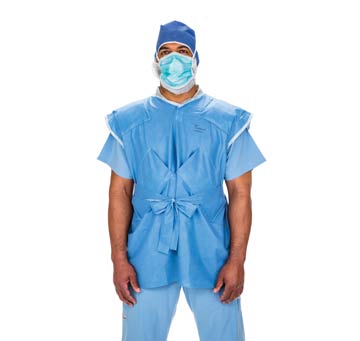You make every effort to ensure your patients’ comfort for the few hours that they pass through your facility, but what about your surgeons and staff? Like gladiators, they emerge from the locker room gloved, gowned and ready to do battle. Day after day, week after week, month after month, they stand and bend and twist and turn under the harsh glare of the OR lights for hours on end. Here are 6 simple things you can do to make the OR a more comfortable working environment for them.
1. Temperature. Cooling vests and gowns lower the body temperature and tension levels of overheated surgeons and staff.
Jill Byrne, MSN, RN, CNOR, an OR nurse at Cleveland Clinic and a doctoral student at Case Western Reserve University, took it upon herself to invent a surgical cooling vest.
“I’ve stood side-by-side with overheated surgeons struggling every day to provide the best patient care possible,” says Ms. Byrne, who’s partnered with Cardinal Health to market her CoolSource Cooling System. “This sparked my pursuit to create an intuitive solution — a cooling vest — to help them stay focused. Beyond performance alone, it has been inspiring to witness the positive impact on OR civility due to improved comfort with the vest.”
On the other side of the climate spectrum, staffers who are shivering from the mid-60s OR temps can wear heated garments that use batteries or electric hookups.
2. Fatigue. Surgical floor mats are an economical way to make standing a bit more comfortable. Some also provide suction for high-fluid procedures, addressing a couple issues at once.
David A. Abrutyn, MD, an orthopedic surgeon at Summit Medical Group Orthopedics in Berkeley Heights, N.J., focuses on sports medicine, so he does a lot of “wet case” procedures such as ACLs and rotator cuffs. He’s been standing on single-use suction mats for 7 years, and he says they’ve proven very beneficial, both in terms of his personal comfort and in keeping the floor dry and clear of cloths.
“If you do 6, 7 cases a day, and you can stand on something that’s more ergonomic, padded and comfortable, that’s better than standing on a hard floor,” he says. “And the suction really facilitates with turnover time, because it reduces cleanup after cases and reduces risk of cross contamination.”
3. OR attire. Footwear is another important aspect of physical OR comfort. Obviously, that begins with shoes. They should protect the feet from fluids and needles, and be slip-resistant, sterilizable, and easy to remove if need be due to cramps or just to give the feet some air. Compression socks are a compelling option; proponents say they increase blood flow and reduce muscle soreness.
Another issue: well-fitting gowns. If the gown is too tight, it can restrict the clinician’s range of motion, which could lead to discomfort and pain over time. Too long, they might trip over it. Soft material with a good fit should be the goal.
.svg?sfvrsn=be606e78_3)

.svg?sfvrsn=56b2f850_5)